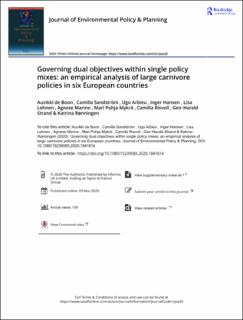Governing dual objectives within single policy mixes: an empirical analysis of large carnivore policies in six European countries
| dc.contributor.author | de BOON, Auvikki | |
| dc.contributor.author | Sandström, Camilla | |
| dc.contributor.author | Arbieu, Ugo | |
| dc.contributor.author | Hansen, Inger | |
| dc.contributor.author | Lehnen, Lisa | |
| dc.contributor.author | Marino, Agnese | |
| dc.contributor.author | Pohja-Mykrä, Mari | |
| dc.contributor.author | Risvoll, Camilla | |
| dc.contributor.author | Strand, Geir-Harald | |
| dc.contributor.author | Rønningen, Katrina | |
| dc.date.accessioned | 2021-01-05T11:55:52Z | |
| dc.date.available | 2021-01-05T11:55:52Z | |
| dc.date.created | 2020-11-06T08:56:24Z | |
| dc.date.issued | 2020 | |
| dc.identifier.issn | 1523-908X | |
| dc.identifier.uri | https://hdl.handle.net/11250/2721462 | |
| dc.description.abstract | Policy mixes (i.e. the total structure of policy processes, strategies, and instruments) are complex constructs that can quickly become incoherent, inconsistent, and incomprehensive. This is amplified when the policy mix strives to meet multiple objectives simultaneously, such as in the case of large carnivore policy mixes. Building on Rogge and Reichardt's analytical framework for the analysis of policy mixes, we compare the policy mixes of Norway, Sweden, Finland, the Netherlands, Germany (specifically Saxony and Bavaria), and Spain (specifically Castilla y León). The study shows that the large carnivore policy mixes in the case countries show signs of lacking vertical and horizontal coherence in the design of policy processes, weak consistency between objectives and designated policy instruments, and, as a consequence, lacking comprehensiveness. We conclude that creating consistent, coherent, and comprehensive policy mixes that build on multiple objectives requires stepping away from sectorized policy development, toward a holistic, systemic approach, strong collaborative structures across policy boundaries and regions, the inclusion of diverse stakeholders, and constant care and attention to address all objectives simultaneously rather than in isolation. | |
| dc.language.iso | eng | |
| dc.title | Governing dual objectives within single policy mixes: an empirical analysis of large carnivore policies in six European countries | |
| dc.type | Peer reviewed | |
| dc.type | Journal article | |
| dc.description.version | publishedVersion | |
| dc.source.journal | Journal of Environmental Policy and Planning | |
| dc.identifier.doi | 10.1080/1523908X.2020.1841614 | |
| dc.identifier.cristin | 1845484 | |
| dc.relation.project | Norges forskningsråd: 267982 | |
| cristin.ispublished | true | |
| cristin.fulltext | original | |
| cristin.qualitycode | 1 |
Tilhørende fil(er)
Denne innførselen finnes i følgende samling(er)
-
Publikasjoner fra Cristin - Nordlandsforskning [223]
-
Vitenskapelige artikler [90]
Vitenskapelige artikler som gir publiseringspoeng i det norske NVI-systemet
